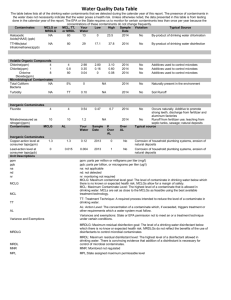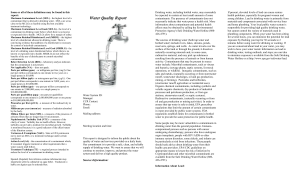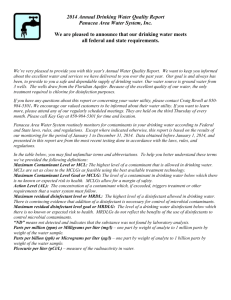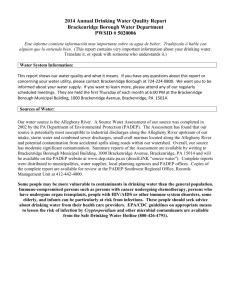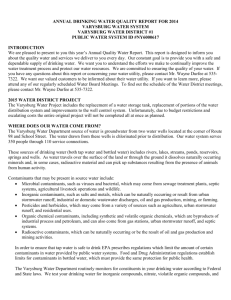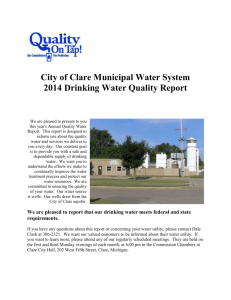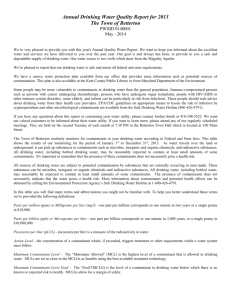2013 CCR Water Quality Report
advertisement
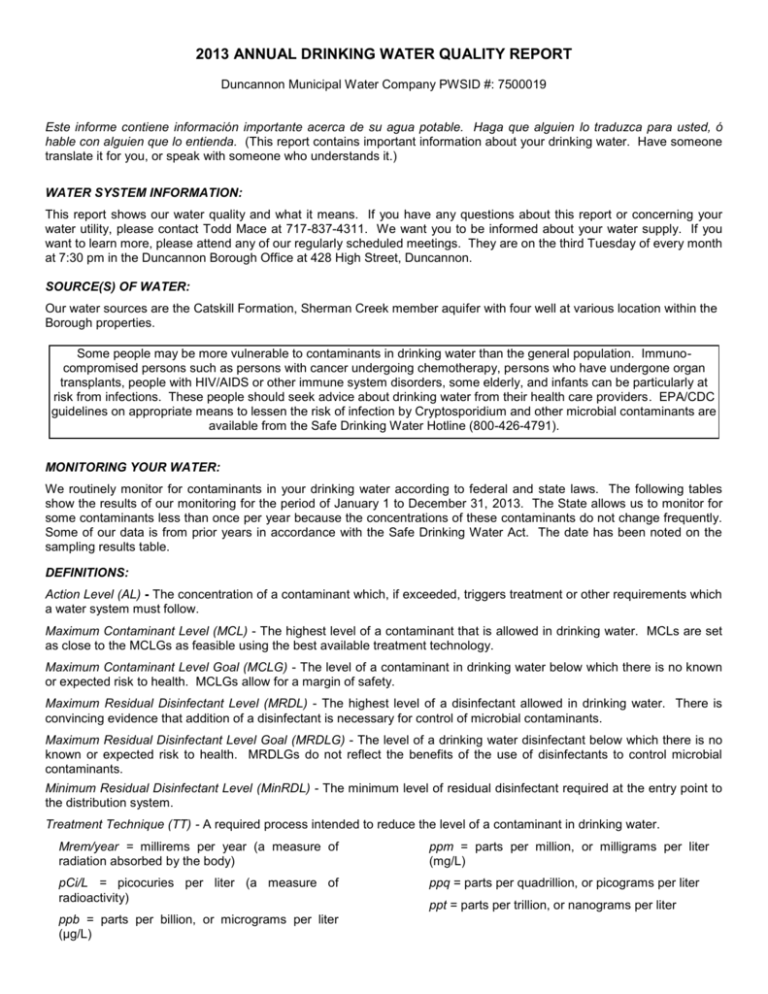
2013 ANNUAL DRINKING WATER QUALITY REPORT Duncannon Municipal Water Company PWSID #: 7500019 Este informe contiene información importante acerca de su agua potable. Haga que alguien lo traduzca para usted, ó hable con alguien que lo entienda. (This report contains important information about your drinking water. Have someone translate it for you, or speak with someone who understands it.) WATER SYSTEM INFORMATION: This report shows our water quality and what it means. If you have any questions about this report or concerning your water utility, please contact Todd Mace at 717-837-4311. We want you to be informed about your water supply. If you want to learn more, please attend any of our regularly scheduled meetings. They are on the third Tuesday of every month at 7:30 pm in the Duncannon Borough Office at 428 High Street, Duncannon. SOURCE(S) OF WATER: Our water sources are the Catskill Formation, Sherman Creek member aquifer with four well at various location within the Borough properties. Some people may be more vulnerable to contaminants in drinking water than the general population. Immunocompromised persons such as persons with cancer undergoing chemotherapy, persons who have undergone organ transplants, people with HIV/AIDS or other immune system disorders, some elderly, and infants can be particularly at risk from infections. These people should seek advice about drinking water from their health care providers. EPA/CDC guidelines on appropriate means to lessen the risk of infection by Cryptosporidium and other microbial contaminants are available from the Safe Drinking Water Hotline (800-426-4791). MONITORING YOUR WATER: We routinely monitor for contaminants in your drinking water according to federal and state laws. The following tables show the results of our monitoring for the period of January 1 to December 31, 2013. The State allows us to monitor for some contaminants less than once per year because the concentrations of these contaminants do not change frequently. Some of our data is from prior years in accordance with the Safe Drinking Water Act. The date has been noted on the sampling results table. DEFINITIONS: Action Level (AL) - The concentration of a contaminant which, if exceeded, triggers treatment or other requirements which a water system must follow. Maximum Contaminant Level (MCL) - The highest level of a contaminant that is allowed in drinking water. MCLs are set as close to the MCLGs as feasible using the best available treatment technology. Maximum Contaminant Level Goal (MCLG) - The level of a contaminant in drinking water below which there is no known or expected risk to health. MCLGs allow for a margin of safety. Maximum Residual Disinfectant Level (MRDL) - The highest level of a disinfectant allowed in drinking water. There is convincing evidence that addition of a disinfectant is necessary for control of microbial contaminants. Maximum Residual Disinfectant Level Goal (MRDLG) - The level of a drinking water disinfectant below which there is no known or expected risk to health. MRDLGs do not reflect the benefits of the use of disinfectants to control microbial contaminants. Minimum Residual Disinfectant Level (MinRDL) - The minimum level of residual disinfectant required at the entry point to the distribution system. Treatment Technique (TT) - A required process intended to reduce the level of a contaminant in drinking water. Mrem/year = millirems per year (a measure of radiation absorbed by the body) ppm = parts per million, or milligrams per liter (mg/L) pCi/L = picocuries per liter (a measure of radioactivity) ppq = parts per quadrillion, or picograms per liter ppb = parts per billion, or micrograms per liter (μg/L) ppt = parts per trillion, or nanograms per liter DETECTED SAMPLE RESULTS: Chemical Contaminants Contaminant MCL in CCR Units MCLG Level Detected Range of Detections Sample Date Units Violation Y/N Nitrate 10 10 5 0.2 – 5.2 ppm 2013 N Chlorine 4 4 1.78 0.51 – 1.78 ppm 2013 N Arsenic 10 0 6.7 3.2 – 6.7 ppb 2012 N Barium 2 2 0.3 0.09 – 0.3 ppm 2012 N Trihalomethanes 80 80 27.4 N/A ppb 2013 N Chromium 100 100 0.02 N/A ppb 2012 N Haloacetic Acids 60 N/A 4.4 N/A ppb 2013 N Sources of Contamination Runoff from fertilizer use; Leaching from septic tanks, sewage; Erosion of natural deposits Water additive used to control microbes Erosion of natural deposits; Runoff from orchards; Runoff from glass and electronics production wastes Discharge of drilling wastes; Discharge from metal refineries; Erosion of natural deposits. By-product of drinking water chlorination Discharge from steel and pulp mills; Erosion of natural deposits By-product of drinking water disinfection *EPA’s MCL for fluoride is 4 ppm. However, Pennsylvania has set a lower MCL to better protect human health. Contaminant Chlorine Entry Point Disinfectant Residual Minimum Lowest Range of Sample Disinfectant Level Units Detections Date Residual Detected 0.40 0.47 0.47 – 2.2 ppm Violation Y/N Sources of Contamination N Water additive used to control microbes. 2013 Lead and Copper Contaminant th Action MCLG 90 Percentile Level (AL) Value Units # of Sites Above AL of Total Sites Violation Y/N Sources of Contamination Lead 15 0 2.7 ppb 0 N Corrosion of household plumbing. Copper 1.3 1.3 0.54 ppm 0 N Corrosion of household plumbing. Microbial Contaminants MCL MCLG Highest # or % of Violation Positive Samples Y/N Sources of Contamination For systems that collect <40 samples/month: Total Coliform Bacteria More than 1 positive monthly sample For systems that collect ≥ 40 samples/month: 0 1 N Naturally present in the environment. 0 0 N Human and animal fecal waste. 5% of monthly samples are positive Fecal Coliform Bacteria or E. coli 0 OTHER VIOLATIONS: See Attached Public Notification Letter EDUCATIONAL INFORMATION: The sources of drinking water (both tap water and bottled water) include rivers, lakes, streams, ponds, reservoirs, springs and wells. As water travels over the surface of the land or through the ground, it dissolves naturally-occurring minerals and, in some cases, radioactive material, and can pick up substances resulting from the presence of animals or from human activity. Contaminants that may be present in source water include: Microbial contaminants, such as viruses and bacteria, which may come from sewage treatment plants, septic systems, agricultural livestock operations, and wildlife. Inorganic contaminants, such as salts and metals, which can be naturally-occurring or result from urban stormwater run-off, industrial or domestic wastewater discharges, oil and gas production, mining, or farming. Pesticides and herbicides, which may come from a variety of sources such as agriculture, urban stormwater runoff, and residential uses. Organic chemical contaminants, including synthetic and volatile organic chemicals, which are by-products of industrial processes and petroleum production, and can also come from gas stations, urban stormwater runoff, and septic systems. Radioactive contaminants, which can be naturally-occurring or be the result of oil and gas production and mining activities. In order to ensure that tap water is safe to drink, EPA and DEP prescribes regulations which limit the amount of certain contaminants in water provided by public water systems. FDA and DEP regulations establish limits for contaminants in bottled water which must provide the same protection for public health. Drinking water, including bottled water, may reasonably be expected to contain at least small amounts of some contaminants. The presence of contaminants does not necessarily indicate that water poses a health risk. More information about contaminants and potential health effects can be obtained by calling the Environmental Protection Agency’s Safe Drinking Water Hotline (800-426-4791). Information about Lead If present, elevated levels of lead can cause serious health problems, especially for pregnant women and young children. Lead in drinking water is primarily from materials and components associated with service lines and home plumbing. Duncannon Borough is responsible for providing high quality drinking water, but cannot control the variety of materials used in plumbing components. When your water has been sitting for several hours, you can minimize the potential for lead exposure by flushing your tap for 30 seconds to 2 minutes before using water for drinking or cooking. If you are concerned about lead in your water, you may wish to have your water tested. Information on lead in drinking water, testing methods, and steps you can take to minimize exposure is available from the Safe Drinking Water Hotline or at http://www.epa.gov/safewater/lead. IMPORTANT INFORMATION ABOUT YOUR DRINKING WATER ESTE INFORME CONTIENE INFORMACIÓN IMPORTANTE ACERCA DE SU AGUA POTABLE. HAGA QUE ALGUIEN LO TRADUZCA PARA USTED, O HABLE CON ALGUIEN QUE LO ENTIENDA. Monitoring Requirements Not Met for Duncannon Municipal Water Company PWS ID# 7500019 Our water system violated several drinking water standards over the past year. Even though these were not emergencies, as our customers, you have a right to know what happened and what we did to correct these situations. We are required to monitor your drinking water for specific contaminants on a regular basis. Results of regular monitoring are an indicator of whether or not our drinking water meets health standards. During 2013 we did not monitor for several contaminants and therefore cannot be sure of the quality of our drinking water during that time. What should I do? There is nothing you need to do at this time. Also, there are NO adverse health effects to be concerned about. The table below lists the contaminant(s) we did not properly test for during the last year, how often we are supposed to sample for Arsenic, PCBs and Asbestos and how many samples we are supposed to take, how many samples we took, when samples should have been taken, and the date on which follow-up samples were (or will be) taken. Contaminant Arsenic PCBs Asbestos Required sampling frequency Yearly Yearly Tri-Annual Number of samples taken 0 0 0 When all samples should have been taken 2013 2013 2013 When samples were or will be taken 2014 2014 2014 What happened? What was done? The samples were missed during routine sampling events. In no way does this jeopardize the quality of your drinking water! For more information, please contact The Borough Office at 717-837-4311. Please share this information with all the other people who drink this water, especially those who may not have received this notice directly (for example, people in apartments, nursing homes, schools, and businesses). You can do this by posting this notice in a public place or distributing copies by hand or mail.

